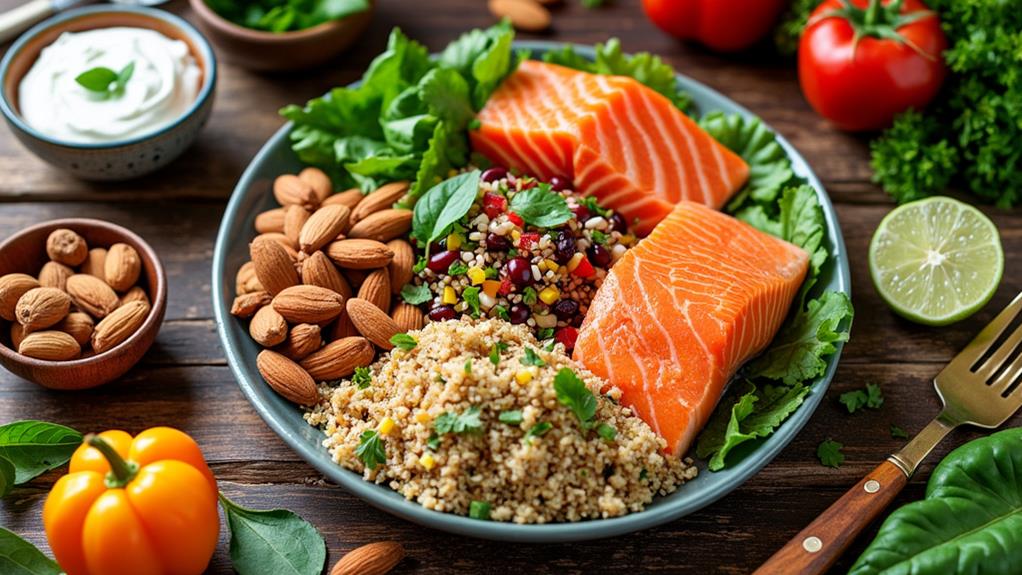Did you know that the right balance of macronutrients can greatly impact your energy levels and overall well-being? When you're planning meals, it's essential to take into account not just what you eat, but how those foods work together to support your body's needs. Understanding the ideal ratios of carbohydrates, proteins, and fats can be a game-changer for your health. So, what does a well-rounded meal plan look like, and how can you create one that fits your lifestyle?
Understanding Macronutrients

Understanding macronutrients is crucial for anyone looking to maintain a balanced diet. Macronutrients include carbohydrates, proteins, and fats, each playing a unique role in your body. Carbohydrates serve as your primary energy source, fueling your daily activities. Proteins are important for repairing tissues and building muscles, while fats help with nutrient absorption and hormone production.
Each macronutrient function contributes to your overall health, so it's significant to consume them in appropriate amounts. When you prioritize dietary balance, you not only enhance your physical performance but also support your mental well-being.
For instance, a diet rich in whole grains, lean proteins, and healthy fats can help regulate blood sugar levels, reduce inflammation, and promote cognitive function.
To achieve this balance, consider your daily caloric needs and the specific roles of each macronutrient. Aim to incorporate a variety of food sources, such as fruits, vegetables, legumes, and nuts, to guarantee you're getting all the essential nutrients.
Importance of Balanced Ratios
Achieving a balanced ratio of macronutrients is essential for optimizing your health and maximizing your energy levels. When you prioritize the right mix of carbohydrates, proteins, and fats, you fuel your body effectively, allowing it to perform at its best. Each macronutrient plays a unique role; carbohydrates provide quick energy, proteins support muscle repair, and fats help with hormone production and nutrient absorption.
Nutrient timing also matters when it comes to achieving balance. Consuming the right macronutrients at strategic times—such as before and after workouts—can enhance performance and recovery. For instance, pairing carbs with protein post-exercise can replenish glycogen stores and facilitate muscle growth.
Moreover, a well-balanced meal plan can help you maintain stable energy levels throughout the day, preventing those dreaded energy crashes that come from imbalanced eating. By focusing on whole foods and emphasizing a variety of sources for each macronutrient, you not only support your body's basic needs but also improve overall health.
Incorporating these principles into your meal plans will empower you to make informed dietary choices that align with your lifestyle and fitness goals.
Protein Sources for Meal Plans

When it comes to meal planning, selecting high-quality protein sources is key to meeting your macronutrient goals. Lean meats like chicken and turkey provide essential amino acids while being low in saturated fat.
Seafood options, such as salmon and shrimp, are also excellent choices, offering omega-3 fatty acids alongside protein. If you prefer plant proteins, legumes like lentils and chickpeas have numerous benefits, including fiber and vitamins.
Incorporating dairy alternatives, such as almond or soy milk, can boost your protein intake without dairy's drawbacks. Protein supplements, like whey or plant-based powders, can be convenient additions, especially post-workout for ideal protein timing.
Cooking methods matter too; grilling, baking, or steaming preserves nutrients while keeping meals healthy.
When meal pairing, combine protein-rich snacks like Greek yogurt or cottage cheese with fruits or nuts for a balanced approach.
Healthy Carbohydrate Options
Healthy carbohydrate options play an essential role in fueling your body and supporting overall wellness. When choosing carbs, focus on whole grains and nutrient-dense fruit choices. Whole grains like brown rice, quinoa, and whole wheat bread are rich in fiber, which aids digestion and helps maintain stable blood sugar levels.
These grains not only provide energy but also contain essential vitamins and minerals.
Incorporating a variety of fruit choices into your diet is equally important. Fruits like berries, apples, and bananas are packed with antioxidants, vitamins, and natural sugars, making them an excellent source of quick energy. They also offer hydration and promote overall health thanks to their high water content and dietary fiber.
Aim to fill half your plate with vegetables and fruits, and include whole grains as your main carbohydrate source. This balanced approach guarantees you get the complex carbohydrates your body needs without the added sugars and refined grains that can lead to energy crashes.
Incorporating Healthy Fats

Incorporating healthy fats into your diet is essential for supporting brain function, hormone production, and overall health. When you choose fat sources wisely, you can enhance your meals' nutrient density while benefiting your body. Healthy fats, such as those found in avocados, nuts, seeds, and olive oil, provide essential fatty acids that your body can't produce on its own.
Aim to replace saturated and trans fats with healthier options. For instance, instead of butter, consider using avocado or nut butters, which offer heart-healthy monounsaturated fats.
Fatty fish, like salmon and mackerel, are excellent sources of omega-3 fatty acids, known for their anti-inflammatory properties and support of cognitive function.
When planning your meals, try to include a variety of healthy fats. This not only boosts the nutrient density of your dishes but also aids in the absorption of fat-soluble vitamins A, D, E, and K.
Sample Meal Plan 1
Creating a balanced meal plan can help guarantee you're getting the right mix of macronutrients to support your health goals. Here's a sample meal plan that emphasizes meal timing and portion control:
- Breakfast: Scramble two eggs with spinach and tomatoes, served with a slice of whole-grain toast. This meal provides protein and healthy fats to kickstart your day.
- Lunch: Enjoy a grilled chicken salad topped with mixed greens, cucumber, and a vinaigrette dressing. This combination offers lean protein and fiber, promoting satiety while keeping calories in check.
- Dinner: Prepare a baked salmon fillet with quinoa and steamed broccoli. Salmon is rich in omega-3 fatty acids, while quinoa adds complex carbohydrates and protein.
In between meals, consider healthy snacks like a handful of nuts or a piece of fruit.
Keeping your meal timing consistent can help regulate your appetite and energy levels. Remember to practice portion control to avoid overeating.
This balanced approach not only supports your nutritional needs but also fosters a healthy relationship with food. By following this sample meal plan, you'll be well on your way to achieving your health goals!
Sample Meal Plan 2

For those looking to mix up their meal routine while still maintaining balanced macronutrients, Sample Meal Plan 2 offers a fresh perspective. This plan emphasizes meal variety and nutrient density, ensuring you get a wide range of vitamins and minerals.
Start your day with a breakfast of Greek yogurt topped with mixed berries and a sprinkle of chia seeds. This combo provides protein, healthy fats, and antioxidants.
For lunch, try a quinoa salad mixed with chickpeas, cherry tomatoes, and spinach, dressed with olive oil and lemon. This dish isn't only filling but also rich in fiber and plant-based protein.
Dinner can feature grilled salmon served with roasted sweet potatoes and steamed broccoli. Salmon offers omega-3 fatty acids, while sweet potatoes provide complex carbohydrates and fiber.
For a snack, opt for a handful of almonds or carrots with hummus, adding healthy fats and additional nutrients to your diet.
Sample Meal Plan 2 highlights the importance of meal variety and nutrient density, making it easier for you to enjoy flavorful foods while meeting your macronutrient needs.
Adjusting Portions for Goals
Adjusting portion sizes is essential for aligning your meal plan with your specific health goals, whether you're aiming to lose weight, build muscle, or maintain overall wellness.
Effective portion control helps you manage calorie intake while still reaching your nutritional needs. Here are three key strategies for adjusting portions based on your goals:
- Set Clear Goals: Determine what you want to achieve—losing fat, gaining muscle, or simply staying healthy. This clarity will guide your portion sizes and food choices.
- Calculate Nutritional Needs: Use your age, weight, height, and activity level to figure out your daily caloric needs. This calculation will inform how much to eat for each macronutrient.
- Monitor and Adjust: Track your meals and progress regularly. If you're not seeing the results you want, adjust your portion sizes accordingly.
Tips for Meal Prep

Meal prepping can be a game changer when it comes to maintaining a balanced macronutrient intake. To get started, focus on meal prep essentials like containers, a good knife, and cutting boards. Invest in high-quality, BPA-free containers that are microwave and dishwasher safe, as these will make storing and reheating meals easier.
Next, use time-saving techniques to maximize efficiency. Batch cooking is a great strategy; prepare larger portions of grains, proteins, and vegetables that can be mixed and matched throughout the week. This not only saves time but also guarantees you have a variety of meals ready to go.
Consider organizing your meal prep day by planning out your recipes in advance. Create a shopping list based on these recipes, which helps you stick to your nutritional goals. When you do cook, try to make use of one-pot meals or sheet pan recipes to minimize cleanup.
Lastly, label your containers with the date and contents. This helps you keep track of freshness and guarantees you eat the meals you've prepared. By implementing these tips, you'll find that sticking to a balanced macronutrient intake becomes much more manageable.
Common Mistakes to Avoid
One of the biggest pitfalls in meal prepping is underestimating the importance of portion control. If you're not mindful of how much you're serving, you could easily consume more calories than you need, leading to unwanted weight gain.
Balancing your macronutrients is essential, but it won't matter if your portions are out of whack.
Here are three common mistakes to avoid:
- Skipping Meals: It might seem like a good way to cut calories, but skipping meals can throw off your meal timing and lead to overeating later. Aim for regular, balanced meals to keep your metabolism steady.
- Neglecting Protein: Make sure you include enough protein in each meal. It helps with satiety and muscle maintenance. Ignoring this can lead to imbalanced macronutrients.
- Using Large Containers: Storing your meals in oversized containers may encourage larger portions. Use smaller containers to help control your servings better.
Conclusion
Incorporating balanced macronutrients into your meal plans is key to achieving your health goals. By focusing on a mix of lean proteins, healthy carbs, and nutritious fats, you'll fuel your body for the day ahead. Remember, just like your favorite classic rock album, each meal should have the right mix to hit all the right notes. With a little planning and mindfulness, you can enjoy delicious meals that sustain your energy and well-being.















